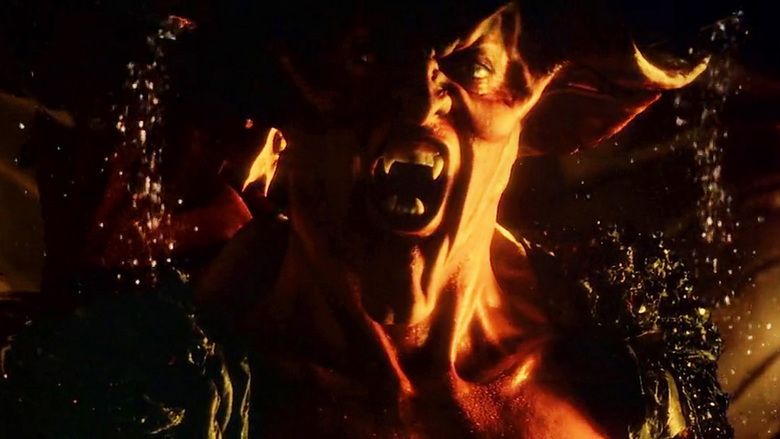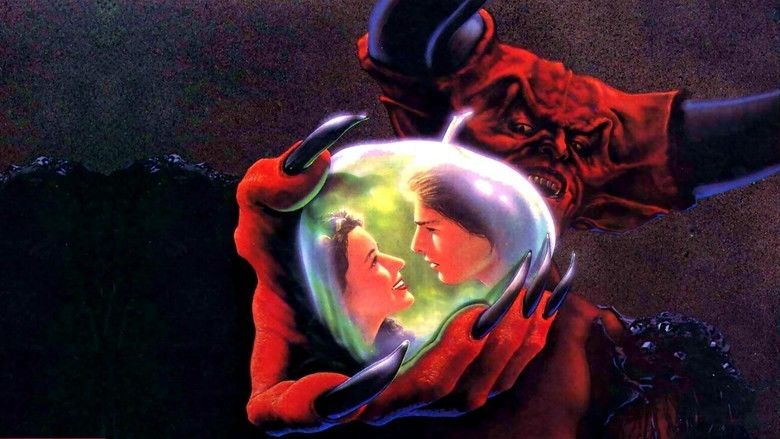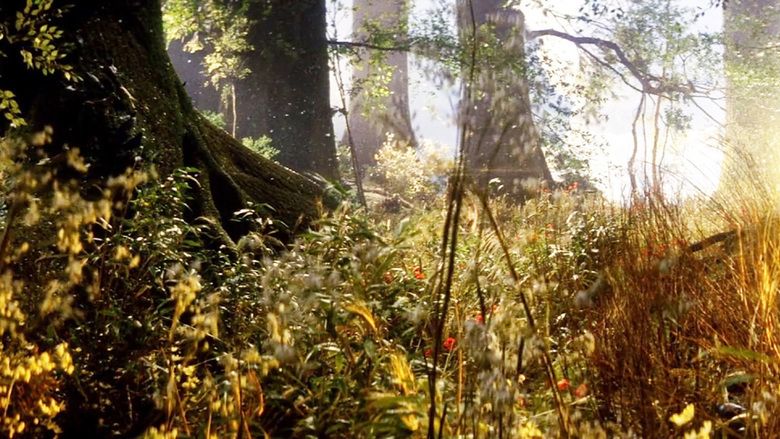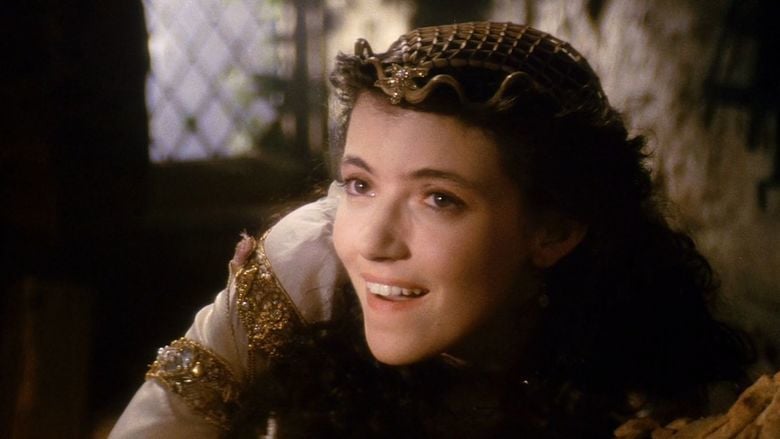Legend (1985 film)
5.8 /10 1 Votes
50% Rotten Tomatoes Genre Adventure, Fantasy, Romance Duration Country United KingdomUnited States | 6.5/10 IMDb Language English | |||||||||||||||||||||||||||||||||
 | ||||||||||||||||||||||||||||||||||
Release date December 13, 1985 (1985-12-13) (UK)April 18, 1986 (1986-04-18) (US) Featured songs Reunited, Bumps and Hollows, Living River Cast (Jack), (Princess Lily), (Darkness), (Honeythorn Gump), (Blix), (Screwball) Similar movies Shrek 2 , The Matrix Reloaded , Shrek , The Matrix Revolutions , Bruce Almighty , Independence Day Tagline There may never be another dawn. | ||||||||||||||||||||||||||||||||||
Legend 1985 trailer hd
Legend is a 1985 American-British dark fantasy adventure film directed by Ridley Scott and starring Tom Cruise, Mia Sara, Tim Curry, David Bennent, Alice Playten, Billy Barty, Cork Hubbert, and Annabelle Lanyon. It is a dark fairy tale and has been described as a return to more original, sometimes disturbing, fables, from the oral tradition of ancient times before reading and writing were widespread.
Contents
- Legend 1985 trailer hd
- Legend 1985 trailer
- Plot
- Alternative endings
- Cast
- Development
- Screenplay
- Pre production
- Casting
- Makeup effects
- Principal photography
- Post production
- Rediscovery
- Reception
- Soundtrack
- Songs in the film
- Home media
- References

Although not a commercial success when first released, it won the British Society of Cinematographers Award for Best Cinematography in 1985 for cinematographer Alex Thomson, as well as being nominated for multiple awards: Academy Award for Best Makeup; Academy of Science Fiction, Fantasy & Horror Films Saturn Award for Best Makeup; BAFTA Awards for Best Costume Design, Best Makeup Artist, Best Special Visual Effects; DVD Exclusive Awards; and Young Artist Awards. Since its premiere and the subsequent release of the Director's Cut edition, the film has become a cult classic, with many critics agreeing the Director's Cut is far superior to the U.S. Theatrical Version.

Legend 1985 trailer
Plot

"Once, long ago", the ancient Lord of Darkness (Tim Curry) laments his isolation in the shadows before sensing the presence of two unicorns who safeguard the Power of light whereupon Darkness instructs Blix (Alice Playten) and his fellow goblins Pox (Peter O'Farrell) and Blunder (Kiran Shah) to kill the unicorns and bring him their horns to free himself. Meanwhile, Princess Lily (Mia Sara), a mischievous and vibrant girl goes alone to the forest to meet her love interest Jack (Tom Cruise), an adventurous and some-what lustful forest dweller who teaches her the languages of animals before showing her the unicorns as he promised he would someday do. Against Jack's pleas, Lily approaches the stallion to stroke him, making him distracted and the perfect target for a poisoned dart from Blix's blowpipe. Once hit, the unicorns bolt, and Lily makes light of Jack's fears and sets him a challenge by throwing her ring into a pond, declaring that she will marry whoever finds it.

Jack, proving his love to Lily, dives into the pond to retrieve it. As the stallion dies from the poison and the goblins seize his horn, the forest and the pond freeze, setting the mortal realm into an apocalyptic winter. Lily runs off in terror before Jack can break the surface of the frozen pond. Taking refuge in a frozen cottage, Lily overhears the goblins talking about their slaying of the unicorn and testing the alicorn's magical powers. She follows them to a rendezvous with Darkness, who orders them to hunt down the mare. In a fit of overconfidence, Blunder challenges Darkness with the stallion's horn in hand, but is instead restrained and taken away.

In the forest, Jack encounters the hot-headed elf Honeythorn Gump (David Bennent, voiced by Alice Playten). Joined by Gump, the fairy Oona (Annabelle Lanyon), and the dwarves Brown Tom and Screwball (Cork Hubbert and Billy Barty), Jack searches for Lily before coming across the lifeless stallion and his mate. Knowing that the horn must be recovered and returned to the stallion, Jack is led by Gump and the others to a cache of ancient weapons while Brown Tom guards the mare. Lily, attempting to make amends for her role in the stallion's death, is captured alongside the mare after Brown Tom is knocked out. Learning what has transpired, Jack and his group enter the ancient temple in the marshes where Darkness resides. Though Jack deals with the swamp hag Meg Mucklebones (Robert Picardo), he and his group fall into a pit trap that takes them to the dungeon. There they encounter Blunder, revealed to be a disguised elf, before he is dragged off by the ogre chefs to be cooked into a pie. Oona saves Jack and the others, and they resume searching for Lily and the mare.

Having fallen in love with Lily, Darkness tempts her; and Lily agrees to wed him on the condition that she kills the mare in the upcoming ritual. Overhearing their conversation, Jack and Gump learn that Darkness can be destroyed by daylight. While saving Blunder, the group take giant metal platters to reflect the sunlight to the chamber where the mare is to be sacrificed. As the ritual begins, Lily frees the unicorn, but is knocked out by Darkness.

Jack fights Darkness while the others relay the light of the setting sun. Jack loses his sword when Darkness has the upper-hand, but then uses the horn from the stallion to stab him. Exposed to the redirected sunlight, Darkness is expelled to a threshold to a dark void-like space, but uses the unicorn's horn to hold on. Darkness knows there is no physical escape; however, he laughs at Jack and warns him that evil and sin lurks in everyone; therefore, even though he will die, they will never truly defeat him. Jack accepts this, but decides to kill Darkness for the unicorn's safety. Jack strikes Darkness' hand, releasing the unicorn's horn, and Darkness is expelled into the void. As Gump returns the stallion's horn, returning him to life, Jack retrieves the ring from the pond and returns it to Lily, reviving her.
Alternative endings

The film concludes (depending on its targeted market) with one of three endings:
Cast
Development
While filming The Duellists in France, Ridley Scott came up with the idea for Legend after another planned project, Tristan and Isolde, fell through temporarily. However, he felt that it was going to be an art film with limited audience appeal and went on to make Alien and did pre-production work on Dune, another halted project, which was eventually finished by director David Lynch. Frustrated, he came back to the idea of filming a fairy tale or mythological story.
For inspiration, Scott read all the classic fairy tales, including ones by the Brothers Grimm. From that, he came up with an idea for a story about a young hermit who is transformed into a hero when he battles the Lord of Darkness in order to rescue a beautiful princess and release the world from a wintery curse.
Screenplay
Scott wanted Legend to have an original screenplay because he felt that "it was far easier to design a story to fit the medium of cinema than bend the medium for an established story". By chance, he discovered several books written by William Hjortsberg and found that the writer had already written several scripts for some unmade lower-budgeted films. Scott asked him if he was interested in writing a fairy tale. Fortunately, he was already writing some and agreed. Scott remembers, "The first notion was to actually make a classical fairy story, but if you actually analyze a classical fairy story, most are either very short, or very complex". The two men bonded over Jean Cocteau's 1946 film of Beauty and the Beast. In January 1981, just before beginning principal photography on Blade Runner, Scott and Hjortsberg spent five weeks working out a rough storyline for what was then called Legend of Darkness.
Originally, Scott "only had the vague notion of something in pursuit of the swiftest steed alive which, of course, was the unicorn". Scott felt that they should have a quest and wanted unicorns as well as magic armor and a sword. Hjortsberg suggested plunging the world into wintery darkness. Hjortsberg's first draft of Legend of Darkness also had Princess Lili slowly transform into a clawed and fur-covered beast who is whipped and sexually seduced by the antagonist (called Baron Couer De Noir in this draft). Scott wanted to show the outside world as little as possible and they settled on the clockmaker's cottage.
Initially, the quest was longer, but it was eventually substantially reduced. Scott wanted to avoid too many subplots that departed from the main story and go for a "more contemporary movement rather than get bogged down in too classical a format". By the time Scott had finished Blade Runner, he and Hjortsberg had a script that was "lengthy, hugely expensive, and impractical in its size and scope". They went through it and took out large sections that were secondary to the story. The two men went through 15 script revisions.
Pre-production
The look Scott envisioned for Legend was influenced somewhat by the style of Disney animation. He had even offered the project to Disney, but they were intimidated by the film's dark tone at a time when Disney still focused on family-friendly material. Visually, he referenced films like Snow White and the Seven Dwarfs, Fantasia and Pinocchio. Early on, Scott worked with Alan Lee as a visual consultant who drew some characters and sketched environments. However, Scott eventually replaced Lee with Assheton Gorton, a production designer whom he had wanted for both Alien and Blade Runner. Scott hired Gorton because he knew "all the pitfalls of shooting exteriors on a soundstage. We both knew that whatever we did would never look absolutely real, but would very quickly gain its own reality and dispense with any feeling of theatricality".
Scott also consulted with effects expert Richard Edlund because the director did not want to limit major character roles to the number of smaller people who could act. At one point, the director considered Mickey Rooney to play one of the major characters but he did not look small enough next to Tom Cruise. Edlund came up with the idea of shooting on 70 mm film stock, taking the negative and reducing the actors to any size they wanted but this was deemed too expensive and Scott had to find an ensemble of small actors. Legend would be financed with a budget of $24.5 million, and would be distributed by Universal Pictures in North America and by 20th Century Fox in all other territories.
In order to achieve the look of Legend that he wanted, Scott scouted locations in the Sequoias of Yosemite National Park to see the grand scale of trees there. "The whole environment is so stunning ... It was so impressive, but I didn't know how you would control it". However, it would cost too much to shoot on location and he decided to build a forest set on the 007 Stage, named after and used for many James Bond films, at Pinewood Studios. The crew spent 14 weeks constructing the forest set, and Scott was worried that it would not look real enough. It was only days before the start of principal photography that it looked good enough to film. The trees were 60 feet high with trunks 30 feet in diameter and were sculpted out of polystyrene built onto tubular scaffolding frames. In addition, other sets were constructed on five huge soundstages.
Casting
While Scott was considering Richard O'Brien to play Meg Mucklebones, he watched The Rocky Horror Picture Show and saw Tim Curry. He thought the actor would be ideal to play the Lord of Darkness because the actor had film and theatrical experience. Tim Curry's make-up as Darkness in 'Legend' is one of the most iconic images in all of fantasy cinema. Scott discovered Mia Sara in a casting session and was impressed by her "good theatrical instincts".
Makeup effects
Scott contacted Rob Bottin, who designed the special makeup effects for The Howling, about working on Blade Runner, but Bottin was already committed to John Carpenter's The Thing. Scott told him about Legend, and towards the end of production on The Thing, Bottin read a script for the film and saw an excellent opportunity to create characters in starring roles.
After wrapping his work with Carpenter, Bottin met with Scott to reduce the number of creatures to a manageable quantity (the script suggested thousands). The process would involve complicated prosthetic makeup that would be worn for up to 60 days with some full body prosthetics. According to Bottin, at the time, Legend had the largest makeup crew ever dedicated to one project. Bottin divided his facility into different shops in order to cover the immense workload. As actors were cast, Bottin and his crew began making life casts and designed characters on drafting paper laid over sketches of the actors' faces. He designed the prosthetics in his Los Angeles studio and spent some time in England occasionally helping with the application of makeup.
With the exception of Cruise and Sara, all the principal actors spent hours every morning having extensive makeup applied. Between 8 and 12 prosthetic pieces were applied individually to each face, then made up, molded and grafted into the actor's face so that the prosthetics moved with their muscles. Each person needed three makeup artists working on them for an average time of three and a half hours spent applying prosthetics. Actor Tim Curry took five and a half hours because his entire body was encased in makeup. Out of all the characters, the most challenging one in terms of makeup was Darkness.
Curry had to wear a large, bull-like structure atop his head with three-foot fiberglass horns supported by a harness underneath the makeup. The horns placed a strain on the back of the actor's neck because they extended forward and not straight up. Bottin and his crew finally came up with horns that were lightweight enough. At the end of the day, he spent an hour in a bath in order to liquefy the soluble spirit gum. At one point, Curry got too impatient and claustrophobic and pulled the makeup off too quickly, tearing off his own skin in the process. Scott had to shoot around the actor for a week as a result.
Principal photography
Principal photography began on March 26, 1984 on the 007 Stage at Pinewood Studios. On June 27, 1984, with ten days filming left on this stage, the entire set burned down during a lunch break. Reportedly, flames from the set fire leapt more than 100 feet into the air and the clouds of smoke could be seen five miles away. Fortunately, it occurred during lunchtime, and no one was hurt. Scott quickly made changes to the shooting schedule and only lost three days moving to another soundstage. Meanwhile, the art department rebuilt the section of the forest set that was needed to complete filming. Due to the fire, the scenes of Lilly meeting the unicorns for the first time and finding the cottages in the snow were filmed in the garden of the main house behind Shepperton Studios. The underwater scenes were filmed in Silver Springs, Florida for the "purity" of the water. Cruise did all his own diving and swimming in waters that, according to Scott, had real alligators 25 feet from where they were filming.
Post-production
Scott's first cut of Legend ran 125 minutes long, & was intended to be a very unpleasant horror film. He then felt there were minor plot points that could be trimmed and cut the film down to 113 minutes and tested this version for an audience in Orange County. However, it was felt that the audience had to work too much to be entertained, and another 20 minutes was cut. The 95-minute version was shown in Great Britain and then the film was cut down even further to 89 minutes for North America.
At the time, Scott said, "European audiences are more sophisticated. They accepted preambles and subtleties whereas the U.S. goes for a much broader stroke." He and Universal delayed the North American theatrical release until 1986 so that they could replace Jerry Goldsmith's score with music by Tangerine Dream, Yes lead singer Jon Anderson, and Bryan Ferry. Similar to later modern noir film adaptations of classic fiction, like Romeo + Juliet in 1996, the soundtrack was deliberately set to add different energy, more depth, increased intensity, and an edgy appeal beyond the traditional fairytale audience of children and parents.
Scott allowed Goldsmith's score to remain on European prints and the composer said, "that this dreamy, bucolic setting is suddenly to be scored by a techno-pop group seems sort of strange to me". Normally, Goldsmith would spend 6–10 weeks on a film score, but for Legend, he spent six months writing songs and dance sequences ahead of time.
Rediscovery
In 2000, Universal unearthed an answer print of the 113-minute preview cut with Jerry Goldsmith's score. This print had minor visual anomalies that were eventually digitally replaced, occasionally with finished shots from the 89-minute U.S. version. This edition is Scott's preferred 2002 "Director's Cut", with the restored Jerry Goldsmith soundtracks. The Director's Cut's source is one of only two prints of this extended version known to exist, used for Universal's 2002 DVD (and eventual Blu-ray) "Ultimate Edition."
Reception
Legend received mixed reviews. Steve Biodrowski of Cinefantastique praised the film, highlighting the makeup design by Rob Bottin and Tim Curry's performance as Darkness, saying that "[b]ecause of the visuals (and Curry's performance, which is mostly limited to the last 20 minutes), the film is worth seeing". Widgett Walls of needcoffee.com also praised the film, once again highlighting Bottin's makeup, focusing on the character of Darkness, saying simply that "Tim Curry's Darkness is absolutely incredible."
Vincent Canby of The New York Times said that "[i]t's a slap-dash amalgam of Old Testament, King Arthur, "The Lord of the Rings" and any number of comic books."
Roger Ebert of the Chicago Sun-Times praised Bottin's makeup and Assheton Gorton's set design and the performances of Curry and Tom Cruise, but noted that the effects were so good that the roles could have been played by almost anyone. Ebert also said that the movie was composed of all of the right ingredients to be successful, but that the film simply "doesn't work". He went on to say that "[a]ll of the special effects in the world, and all of the great makeup, and all of the great Muppet creatures can't save a movie that has no clear idea of its own mission and no joy in its own accomplishment". However, with the release of the 2002 Director's Cut, he agreed with many fans on how it was intended to question the balance between good and evil.
The film was not a commercial success and did not recover its budget. However, it has won a cult following and was recognized for excellence with the British Society of Cinematographers Award for Best Cinematography in 1985, and multiple award nominations: Academy Award for Best Makeup; Academy of Science Fiction, Fantasy & Horror Films Saturn Award for Best Makeup; BAFTA Awards for Best Costume Design, Best Makeup Artist, Best Special Visual Effects; DVD Exclusive Awards; and Young Artist Awards, and since its initial release, has developed an increasing fanbase. In addition, the release of the Director's Cut in 2002, with the original soundtrack restored, brought renewed attention to the film. The Director's Cut was seen as a more well-made and thought provoking film, as it dives into the concept and consequences of purity and sins.
Soundtrack
Due to the changes in the film from its European and American releases, Legend has two different soundtracks. The first, produced and composed by Jerry Goldsmith, was used for its initial European release and restored in the director's cut edition of the Region 1 DVD release. The second soundtrack features music by German electronic artists Tangerine Dream and was used for the initial theatrical and home video releases in the United States. This soundtrack also includes songs by Jon Anderson of Yes and Bryan Ferry of Roxy Music. Both soundtracks are available on CD, although the Tangerine Dream soundtrack has become harder to find.
Songs in the film
The following songs are featured in the European and Director's Cuts, with lyrics composed by John Bettis (composer of many Carpenters songs) and music by Jerry Goldsmith:
The following songs appeared in the 89-minute U.S. re-cut when it was re-scored by Tangerine Dream:
A promotional music video (presumably for the U.S. market, where the Tangerine Dream soundtrack was used) was created for the Bryan Ferry song "Is Your Love Strong Enough". The video, which incorporates Ferry and guitarist David Gilmour into footage from the film, is included as a bonus on disc 2 of the 2002 "Ultimate Edition" DVD release.
Home media
In 2002, Universal released the aforementioned 113-minute "director's cut" on Region 1 DVD restoring previously cut scenes, and the original Goldsmith score. In creating the director's cut edition, producer Charles de Lauzirika turned to Legend fan and unofficial historian Sean Murphy, who runs the Legend FAQ, and Terry Rawlings, the editor of Legend, for help in finding the footage for the Ultimate DVD creation.
Universal has released a Blu-ray version of the "Ultimate Edition" as of May 31, 2011. With the exception of the 2002 DVD-ROM features, this disc carries over all the content from the DVD, including the Jerry Goldsmith-scored "Director's Cut" and the Tangerine Dream-scored theatrical version.
20th Century Fox, the international rights holder, has released a Blu-ray issue for Region 2 of both the 94-minute European version and the 113-minute director's cut (both with Jerry Goldsmith's music).
References
Legend (1985 film) WikipediaLegend (1985 film) IMDbLegend (1985 film) Rotten TomatoesLegend (1985 film) themoviedb.org
